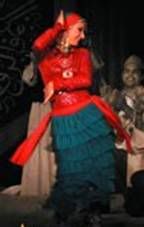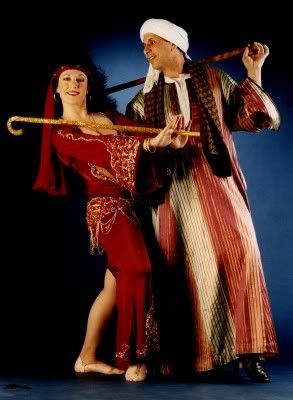Hagalla (Mahmoud Reda)
"I am not doing folklore. It is inspired by folklore." - Mahmoud Reda, July 31, 2006.
The Western Desert
The dance called the hagalla comes from the western desert region of Egypt. (See the shaded area on the map.) Hagalla is generally believed to be a Libyan dance tradition which was brought to Egypt by Libyan migrants.
In the course of researching Egyptian folk culture, Mahmoud Reda would approach the local governors with his request. They in turn would try to arrange opportunities for him to see local music and dance. For his research into the western desert folk culture, Reda decided to travel to Mersa Matrouh, which is very near the Libyan border.
Mersa Matrouh is along the Mediterranean coast, about halfway between Alexandria and the Libyan border. Today, a road which takes about 4 hours to travel one way connects Mersa Matrouh with Siwa. However, back when Reda was conducting his research, there was no such road. Traveling from Mersa Matrouh to Siwa took about 10 hours, allowing time to get lost along the way and double back.
Arranging to See It
When Reda arrived in Mersa Matrouh, he contacted the local officials to request their cooperation in helping him arrange to see local folk dance. Unfortunately, the General Secretary was sick, so Reda worked with his assistant. He was told that a wedding was scheduled for the coming Thursday, but it was early in the week and Reda's schedule did not allow him to stay that long. The official then said he would let that couple marry yet that same night. Of course, there was the difficulty of notifying all of the guests of the change in plans. The official handled this by sending his people out in the wee hours of the morning to fire guns in the street to wake people up. When they stuck their heads out the windows to investigate what the noise was about, they were told of the change in plans for scheduling the wedding.
Observing the Dance
In the environment observed by Reda, the hagalla dance was performed by a professional dancer at a wedding. The term "el hagalla" referred to the dancer herself. For this wedding, the dancer prepared herself inside the house, where the women were, while Reda waited with the men outdoors. Because he was a man, there was no opportunity for Reda to see what occurred inside the house while the dancer was still inside with the other women.
The gathered men were eager and began to clap in a simple, steady rhythm of one clap per count. The dancer waited, holding back, waiting for the claps to build in volume and intensity. Eventually she came outdoors to perform for them. The men were standing in little clumps - 3-4 in one place, 4-5 in another. The dancer headed for the group that was clapping the most loudly and danced for them. Another group became jealous and started clapping more loudly, to attract her over to dance for them. One man might go down on one knee to clap to show his excitement, another might lie on his side while continuing to clap. The men didn't actually dance, just clapped and acted enthusiastic to get the dancer's attention. This activity continued for about an hour, with the dancer moving from group to group to dance for them.
The movement by the dancer is very simple. Reda demonstrated it in the interview, and it is what many Americans call the ¾ shimmy, the version where the hip on the weighted leg goes down, up, down. He observed that the dancer lifted her feet, which made sense in the sandy desert where sliding motions with the feet would be impractical. During his visit to Mersa Matrouh, he also observed a fat woman walking normally and noticed that her hips too went up and down in this shimmy motion, without her consciously trying to dance.
Different people have reported different stories about the role of the female dancer. In the wedding celebration that Reda observed, the dancer was definitely not the bride, nor was she a young woman seeking to attract suitors. In Egypt, it was customary for marriages to be arranged. The dancer Reda witnessed was a professional entertainer, hired to provide entertainment for the occasion.
Bringing It to Stage
Theater audiences wouldn't have much patience for listening to an hour straight of simple clapping, nor would their attention be held for long by watching a dancer strut back and forth in front of a row of clapping men doing the same move continuously. Therefore, Reda made some modifications to the hagalla when using it in choreography.
This screen shot shows a scene from a Reda Troupe performance of the hagalla which appeared in the 1965 Egyptian movie Gharam fi al-Karnak (Love in Karnak). The woman dancing is Farida Fahmy.
One adaptation for stage involved adding music, rather than just the continuous clapping.
Another adaptation was addition of movement which was not traditional. Because the men in the village approached the dancer and tried to get her attention, it was plausible to place the men in the choreography in a circle around the dancer and choreograph moves for them to use in vying for her attention.
The original choreography Reda created that was based on this dance utilized 15 men and one woman. The men were arranged in three groups of five men each. Their efforts to draw the woman's attention were exaggerated for stage purposes. A later Reda choreography depicted the hagalla with the men doing flashy steps based on Russian folk dance moves in a circle around the women.
For the dancer, it was necessary to add all possible variations to the basic shimmy move - traveling forward, backward, sideways, in floor patterns, etc. It was necessary to use the imagination, but still to stay in character. Pirouettes, for example, wouldn't have been logical.
Costuming
The costumes Reda Troupe used for hagalla were influenced by the clothing of Libyan women. Just as the village dancer had a sort of peplum effect to her skirt around her hips, so did the woman in the troupe choreography. The women wore flat boots of soft leather.
Haggala (Shokry Mohamed)
Las Danzas Folklóricas en Egipto son todas marcadamente diferentes entre sí. Cada región tiene sus danzas, incluso hay regiones que tienen un tipo de canto propio, un dialecto y costumbres distintas de las demás regiones.Haggala es la danza típica de los Oasis del Desierto Occidental de Egipto y es común con la vecina Libia. La palabra Haggala viene de hagl, que significa salto. Hay otra palabra que probablemente se relaciona también con esta danza, hegel, que es una pulsera de plata que rodea la parte inferior del tobillo y que llevan las jóvenes egipcias del Alto Egipto.Todos sabemos de la costumbre en el mundo árabe de que el hombre elija a la mujer cuando quiere casarse, pero en los oasis de Siwa sucede exactamente al contrario, por extraño que parezca. El día de la boda se reúnen todos los jóvenes y hombres del pueblo a la intemperie, formando una larga fila. Todo comienza con el fuerte batir de palmas de los hombres, acompañado por los ritmos de los panderos. La novia sabe muy bien quién es su elegido, pero ningún joven sabe exactamente quién es el afortunado. La joven baila durante bastante tiempo con su cara tapada por un shall transparente desde donde puede ver a los hombres sin dejar que ellos la vean. Mientras el ritmo está en su plena fuerza, ella se va parando frente a uno de los jóvenes y le baila durante unos minutos, luego le deja y baila frente a otro, repitiéndolo con cada uno de ellos hasta llegar al final de la fila. Cuando esto sucede, se coloca frente al elegido y enlaza sus manos de una forma cruzada, bailando sólo para él, su futuro marido. Si éste tiene alguna joya o algún abalorio lo ofrece a su futura mujer. En este momento los demás hombres tocan las palmas de una forma continuada y los familiares de ambos se acercan, se saludan y se abrazan dándose la enhorabuena. La danza y los gritos continúan mientras los recién casados cruzan la fiesta para dirigirse juntos a su nuevo hogar

